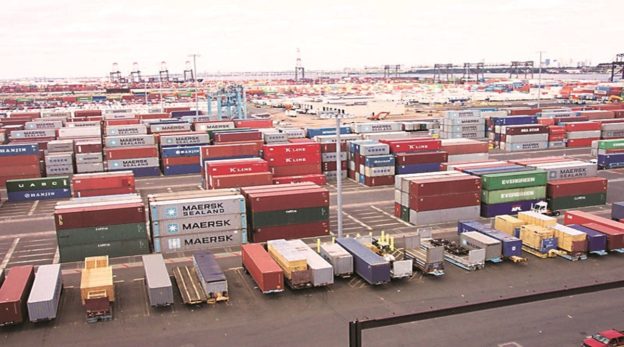For the first time, annual goods exports have touched $400 billion; on adding services exports, the total will be close to $650 billion. With 13 months of exports, this hugely-positive change can be a trend.
The $30 billion a month mark has historically been the “psychological barrier” for Indian exports. When in March 2021, the goods exports crossed the mark comfortably, the lazy analysis in the opinion pieces was a regurgitation of usual ideas—commodity prices are up, there is a shipping cost inflation, it’s just a blip and so on. The analysis—and the failure to spot an emerging trend—could not have been more wrong. From March 2021-February 2022, every month has clocked more than $30 billion in goods exports. The trend will quite likely continue for March 2022 as well. For the first time in Indian trade history, the annual goods exports have touched $400 billion and the final number for the year maybe close to $410 billion. Once the services exports data is added, the total exports will end up close to $650 billion mark. This will place India close to top ten exporting nations in the world, if not within the top ten itself. With a strong 13 months of goods and services export, it is fair to call this hugely positive change a trend rather than a blip.
There are three significant aspects which characterize India’s emerging increased trade competitiveness and global integration. First, the $400 billion goods export and $650 billion total export number is an outcome of meticulous planning and the focus on Aatmanirbhar Bharat. Prime Minister Narendra Modi had talked about the need for rejuvenating the industrial economy, where India leverages its large market and human capital talent base. Following that, the industry and various government bodies have come together with a renewed emphasis to develop capabilities for great value addition in India. On its part, the Centre assessed trade potential with different countries analysing past trends. About 200 countries or territories were analysed closely to understand how Indian strengths can match market demands for each entity. Indian missions, territorial divisions in ministries, industry bodies and export promotion bodies coordinated to make sure that every potential opportunity was pursued. PM Modi led this, speaking to all Indian missions in August 2021, and stressing the potential of Indian industry in the exports markets.
Second, a large part of the $400 billion goods export involves domestic value addition. A historical quip about Indian exports has been that we ship out a lot of raw material or low value-added products. However, in the FY 22, top product categories paint a different and a very optimistic picture. Till March 21, the day India hit the $400billion exports mark, the top category of exports has been engineering goods, clocking nearly $108 billion. Processed petroleum products were next at $59.6 billion, followed by gems and jewellery at $37.7 billion, organic and inorganic chemicals at $28.2 billion, and drugs and pharmaceutical at $23.7 billion. This export basket clearly indicates that the upswing is driven by real manufacturing capabilities. There is always room for improvement and increasing the India-based value add. But the numbers clearly speak for themselves—this is a manufacturing driven export revival. For reference, exports of pure raw materials like mica, coal and other ores and minerals were at $5 billion, ranking only thirteenth as a category. Iron ore exports amounted to $3.1 billion, the eighteenth most valuable category. This is a testament to the success of a broader industrial policy driven by domestic capability enhancement and upskilling. The Indian consumer is getting access to even better products and the world is turning to India to fulfil more of its goods demand.
Third, several breakthrough categories have stood out for the first time. India’s electronic goods exports were at $15 billion, already the seventh-biggest export category. Of these, $5.5 billion will just be mobile phone exports, a category where India had very little manufacturing presence just five years back. Same is the case for defence equipment. India would earn about $1.5 billion in export revenue this year, up nearly six times in the last eight years. This trend is best visible in agriculture items. From Banganapalli and Suvarnarekha mangoes of Andhra Pradesh going to South Korea; Palghar’s sapota, Uttar Pradesh’s jamuns, and Bihar’s litchis going to the UK; and Jalgaon’s bananas, Sangli’s dragon fruit, Assam’s Burmese grapes and Madurai’s flowers reaching the UAE, a lot of new ground has been broken. This is important because the benefits of trade in such products accrue to market participants with a relatively smaller economic size. These breakthrough categories may individually look small, but at the margin, they can make a huge positive difference to the participants involved. India recently signed a Comprehensive Economic Partnership Agreement with the UAE. Trade deals in various formats are also being discussed with the UK, Australia, and Canada. This is significant because all these countries have significant bilateral trade potential, with the UAE and the UK being part of India’s top ten export destinations.
With the Pradhan Mantri Gati Shakti plan working on reducing logistics costs and friction and creating signature infrastructure assets, products and services from currently untapped Indian destinations will also likely find new markets. A great new era of global trade led growth is unfolding in front of us—a milieu in which India is now a strong and confident player.
https://www.financialexpress.com/opinion/a-new-era-of-exports-takes-off-breaking-the-30-billion-a-month-psychological-barrier-mark/2481603/





